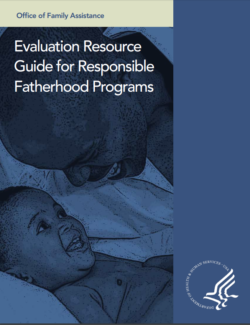Resource | Guide
Evaluation Resource Guide for Responsible Fatherhood Programs
- Authors:
- Chi Connie Park
- Pirkko Ahonen
The Office of Family Assistance, Administration for Children and Families, designed the Responsible Fatherhood program to help fathers overcome barriers to becoming effective and nurturing parents and improve their relationships with their children.
 This resource guide was developed to support the planning and evaluation of the Responsible Fatherhood projects. The guide contains the following chapters:
This resource guide was developed to support the planning and evaluation of the Responsible Fatherhood projects. The guide contains the following chapters:
- Chapter 1 introduces the concept and purpose of program evaluation, information to be gained, and how to use evaluation information to inform projects.
- Chapter 2 includes an overview of the Responsible Fatherhood initiative and conceptual model and a discussion on defining a program model.
- Chapter 3 describes the topic of program theory.
- Chapter 4 discusses logic models and provides tools for developing one.
- Chapter 5 explains how to develop and review evaluation questions.
- Chapter 6 provides guidance on process evaluation.
- Chapter 7 focuses on outcome evaluation; clarifies short-term, intermediate, and long-term outcomes and corresponding indicators; and includes tools for identifying indicators.
- Chapter 8 presents more discussion on how to measure project outcomes. The chapter explains the difference between descriptive and comparative evaluation designs, and it offers an overview of common evaluation designs and data sources applicable to Responsible Fatherhood grantees.
- Chapter 9 provides information on selecting and developing appropriate evaluation instruments.

